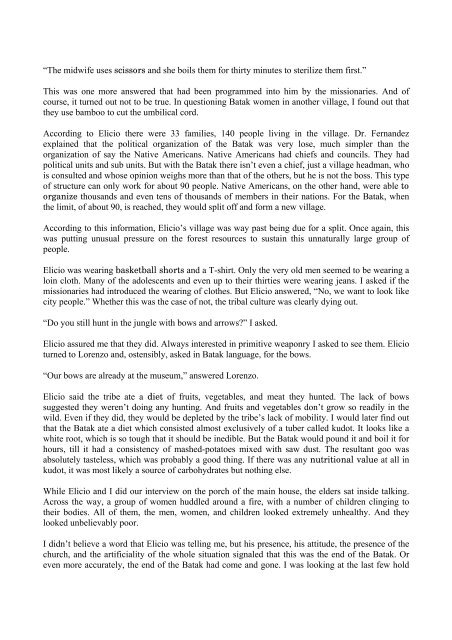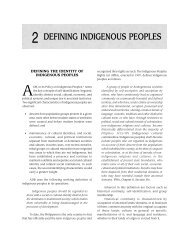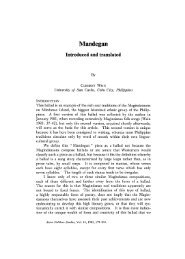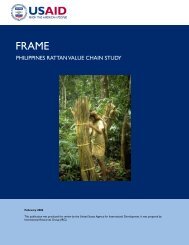The Vanishing Batak Tribe - Ethnic Filipinos, Indigenous & Tribal ...
The Vanishing Batak Tribe - Ethnic Filipinos, Indigenous & Tribal ...
The Vanishing Batak Tribe - Ethnic Filipinos, Indigenous & Tribal ...
Create successful ePaper yourself
Turn your PDF publications into a flip-book with our unique Google optimized e-Paper software.
“<strong>The</strong> midwife uses scissors and she boils them for thirty minutes to sterilize them first.”This was one more answered that had been programmed into him by the missionaries. And ofcourse, it turned out not to be true. In questioning <strong>Batak</strong> women in another village, I found out thatthey use bamboo to cut the umbilical cord.According to Elicio there were 33 families, 140 people living in the village. Dr. Fernandezexplained that the political organization of the <strong>Batak</strong> was very lose, much simpler than theorganization of say the Native Americans. Native Americans had chiefs and councils. <strong>The</strong>y hadpolitical units and sub units. But with the <strong>Batak</strong> there isn’t even a chief, just a village headman, whois consulted and whose opinion weighs more than that of the others, but he is not the boss. This typeof structure can only work for about 90 people. Native Americans, on the other hand, were able toorganize thousands and even tens of thousands of members in their nations. For the <strong>Batak</strong>, whenthe limit, of about 90, is reached, they would split off and form a new village.According to this information, Elicio’s village was way past being due for a split. Once again, thiswas putting unusual pressure on the forest resources to sustain this unnaturally large group ofpeople.Elicio was wearing basketball shorts and a T-shirt. Only the very old men seemed to be wearing aloin cloth. Many of the adolescents and even up to their thirties were wearing jeans. I asked if themissionaries had introduced the wearing of clothes. But Elicio answered, “No, we want to look likecity people.” Whether this was the case of not, the tribal culture was clearly dying out.“Do you still hunt in the jungle with bows and arrows?” I asked.Elicio assured me that they did. Always interested in primitive weaponry I asked to see them. Elicioturned to Lorenzo and, ostensibly, asked in <strong>Batak</strong> language, for the bows.“Our bows are already at the museum,” answered Lorenzo.Elicio said the tribe ate a diet of fruits, vegetables, and meat they hunted. <strong>The</strong> lack of bowssuggested they weren’t doing any hunting. And fruits and vegetables don’t grow so readily in thewild. Even if they did, they would be depleted by the tribe’s lack of mobility. I would later find outthat the <strong>Batak</strong> ate a diet which consisted almost exclusively of a tuber called kudot. It looks like awhite root, which is so tough that it should be inedible. But the <strong>Batak</strong> would pound it and boil it forhours, till it had a consistency of mashed-potatoes mixed with saw dust. <strong>The</strong> resultant goo wasabsolutely tasteless, which was probably a good thing. If there was any nutritional value at all inkudot, it was most likely a source of carbohydrates but nothing else.While Elicio and I did our interview on the porch of the main house, the elders sat inside talking.Across the way, a group of women huddled around a fire, with a number of children clinging totheir bodies. All of them, the men, women, and children looked extremely unhealthy. And theylooked unbelievably poor.I didn’t believe a word that Elicio was telling me, but his presence, his attitude, the presence of thechurch, and the artificiality of the whole situation signaled that this was the end of the <strong>Batak</strong>. Oreven more accurately, the end of the <strong>Batak</strong> had come and gone. I was looking at the last few hold

















